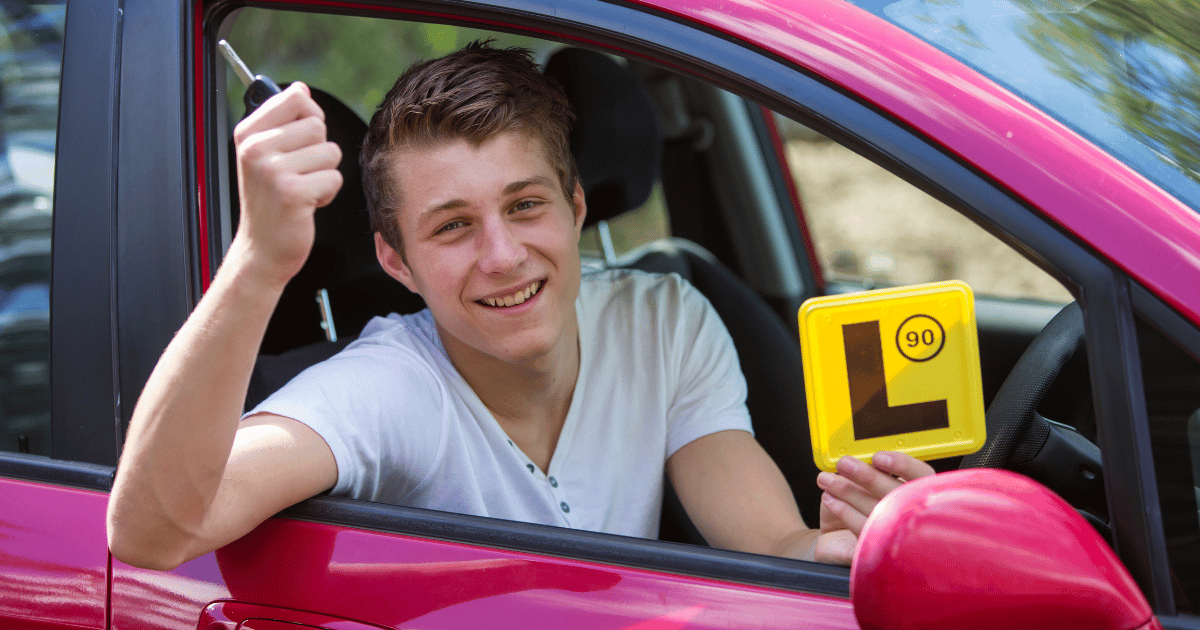
If you are a parent of a teenager on a mission to get their driving license in Australia, then you are faced with a huge task. That is 100 hours of supervised driving with your L plater.
Yes, just as you are navigating the treacherous latter teenage years, you are then forced to sit in the passenger seat of the car they are driving for a whopping 6,000 minutes … which amounts to over four whole days.
I have seen many terrified parents pinned to the passenger seat of cars piloted by their learner-driver kids. I have also done my time supervising a driver for 100 hours … twice.
There are so many things I wish I had known before I started. Things that made logging supervised hours with my youngest daughter much easier than it was for my eldest daughter. Hopefully, by sharing them here I can help other parents and teens about to embark on this long journey to stay safe and stay on talking terms right up to the 100th hour.
Note: The advice provided in this article is from my genuine experience of logging supervised driving hours with my daughters. I am based in QLD. You might live in a different state where rules are different and hours are more (I believe NSW is 120 hours).
Further reading: 12 Tips to co-parent teenagers from a mum who’s been there.
MANUAL OR AUTO
Way before you allow your eager learner to jump into the driver’s seat, think about whether the ultimate goal is to take a driving test for an automatic or manual car. If it is a manual car, then the hours logged must be in a manual car too.
For us, I had one car which was manual so the decision was easy.
There is no right or wrong here but start thinking about what your teen will learn to drive nice and early so you are logging the hours using a car with the right transmission.
INSURANCE FOR LEARNER DRIVERS
I was worried about the cost of insuring my kids on my car. The obvious assumption is that it will be super expensive.
You can imagine my delight when I phoned to enquire and was told there was no cost involved. If my learner has an accident in my car, it’s as if I had the accident so I claim it as normal.
This might not be the case with all car insurance and might vary between states. Make the call to double-check you are insured to the hilt in the most cost-effective way should anything go wrong.
GET DRIVING LESSONS FIRST AND LAST
I am not the best driver. It took me three attempts to pass my test and even now I struggle to parallel park … especially if someone is watching.
I’ll admit that I don’t make a very good driving instructor.
On account of this, I booked driving lessons for both of my girls before I even got in a car with them. This meant they knew the basics before we started logging hours.
In addition, when we had completed the 100 hours, I booked a couple more lessons to get them out of any bad habits I had inadvertently taught them. Book an instructor who will take them out in the car they will take their test in, around the area where the test will happen. The instructor can point out school zones and other tricky areas to be aware of during the test. My daughter would have failed her test had we not done this. It is money well spent because it raises the chance of your teen passing their driving test first time.
Note: For drivers in QLD:
“Every hour of your day time driving with an accredited trainer counts for 3 hours in your logbook—up to a maximum of 10 actual hours or 30 logbook hours.”
START SLOW AND EASY
When you get in the car together in the reverse roles of child driving parent, take it nice and slow, and not just in terms of speed.
Choose times of day when there is little traffic on the road and go to flat areas where the driving is easy and there is nothing complex to compete with.
Keep the first driving sessions short, about 15-minutes, and make sure you don’t have to be anywhere at a certain time so neither of you is stressed. The focus needs to be 100% on the road for both of you.
STAY CALM DURING SUPERVISED DRIVING
It is not always easy to stay calm when your teen is driving your car, but it is imperative that you do.
If your child feels your tension, they will feel tense and this will affect their driving.
If you shout at them, even unintentionally, it will put them on edge and mistakes are more likely to happen.
Practice being calm by talking slowly and keeping your tone low. If you don’t feel capable of doing this (and sometimes we can’t) don’t let them drive and save the supervised driving for another time.
HOW TO DO SUPERVISED DRIVING (CONT.)
PRAISE YOUR LEARNER DRIVER
Supervised driving is not just about sitting in the passenger seat checking your emails. In fact, it is illegal to use your phone when supervising an L-plater.
Every drive is a lesson and it is your job to point out what they are doing wrong so they can correct their mistake next time. Be careful though as our super-sensitive teens will take this as criticism and may get defensive.
As well as pointing out mistakes, be sure to add lots of praise. So whenever they do something right mention that too. You will find you are talking more than a Grand Prix commentator but it will keep up their spirits and their confidence, which is super important.
DON’T TOLERATE DANGEROUS DRIVING
There comes a stage when your teen starts to feel confident behind the wheel. This is great, especially if like my youngest, driving didn’t come naturally.
Be careful though as becoming too confident can often mean dangerous driving. For example, not stopping and looking properly at T-junctions, taking risks on roundabouts, and pulling out in front of cars because they “thought it would be ok”.
Put a stop to this straight away.
I told my girls if they drove dangerously again, I would stop supervised driving for a week. This is a great incentive as they want to get their hours up and they need you to do it.
GO CRAZY WITH THE L PLATES
I don’t know about you but I want everyone on the road to know that my child is driving my car. Yes, the very same person whose nappies I was changing what seems like only yesterday.
As per Queensland Transport:
“You must display L plates so the letter ‘L’ on each plate can be seen clearly at the front and rear of the vehicle (rear only for motorcycles) from 20m away.”
This is the bare minimum and I highly recommend sticking two L-plates on each the front and the back of the car so even the vehicle two cars behind can see you are a learner.
You find people are more considerate on the roads when they know you have a learner driver at the wheel. Not always … but most of the time.
ROAD RAGE
Your little learner won’t have to be in the driver’s seat long to witness road rage.
One of the most shocking things that happened to us was people beeping their horns if we took a while to pull out at a junction, roundabout or traffic lights. Yes, that is right. Road users beep horns at learner drivers. Not only is it illegal (here in QLD) but it is counterproductive as it would upset my girls and it takes them even longer to pull out.
Use these moments of witnessing low human tolerance and compassion to talk to your teen about road rage. How it doesn’t help anyone and can upset other drivers and even cause accidents.
I explained to both my girls that you don’t what the drivers in the other cars are going through. The person in front might be driving slowly because they have had some bad news or are suddenly feeling dizzy. Getting angry and beeping your horn is not going to help them, or you.
JUST KEEP DRIVING
There were times for me, especially at the beginning, when the driving was so bad that I honestly felt I couldn’t do it. The thought of 100 hours gripping the edge of my seat and clenching my jaw was too much to bear.
But keep going because I promise you that the more you drive, the better your teen will get and the more you will relax until it becomes something very close to enjoyable. For me, this happened around the 50-hour mark with both of my daughters. Of course, every learner will be different.
Just. Keep. On. Going.
ADVICE FROM A PARENT ON SUPERVISED DRIVING
THE SHORT JOURNEYS COUNT
Get into the habit of letting your teen drive at every available opportunity. Even a 5-minute drive to get milk.
Long drives are great but it’s the little drives that make the hours add up. It will also give them more consistence practice.
SET MILESTONES
Doing 100 hours of supervised driving is daunting for both driver and supervisor.
Like with all goals, it can help to break it down into smaller goals which earn rewards.
My girls always wanted to put music on while we drove which I wouldn’t allow at first. But, I said when they reach 50 hours, we’ll put the radio on, then at 80 hours they could play their own playlists through the car speakers.
GO TO UNFAMILIAR TERRITORY
We live in a small regional town and a majority of our driving was to and from my daughter’s workplaces, after school (which was walking distance from our house) and at weekends. We ended up doing lots of the same journey’s over and over again.
Make a point of going to different places during supervised driving. Ideally, places that are quite different from what your learner driver is used to.
We do very little highway or city driving so getting my girls to drive along the highway and through Brisbane was a challenge, and not a particularly pleasant one. However, there is no doubt that they were better drivers after doing it.
Get out of your comfort zone to give your teen the best practice driving while they are still L-platers.
ENJOY THE ONE-ON-ONE TIME
Supervised driving can come complete with meltdowns and door slamming, from both parent and teen.
However, as the driving gets easier and you both relax into the routine and the weirdness of the role reversal, it is a great opportunity to spend quality time together. The very minute they get their Ps life changes for you both. They have independence and don’t need you as much and you’ll be wondering where the time went and how they grew up so fast.
As a single parent, I didn’t have much one-on-one with my girls, so supervised driving became the perfect opportunity to go for coffee together, do some shopping or simply drive and chat.
TAKE A BREAK FROM SUPERVISED DRIVING
If supervised driving is taking its toll on you, your child, or both, don’t be afraid to take a break. Your teen will not forget what they have learned.
I had to fly back to the UK for three weeks partway through doing 100 hours with my youngest. I fretted about her missing out on driving and us having to go back to hand-break starts and all the basics. But, a strange thing happened. When she got back behind the wheel, she drove brilliantly. We were both amazed.
If there is a science behind this, I have no idea what it is. Just don’t be afraid to take a break if you need to. It might help.













